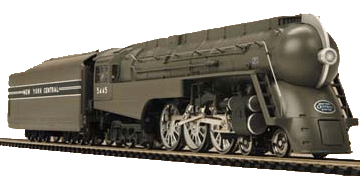|
|
 Posted - January 23 2010 : 5:38:36 PM Posted - January 23 2010 : 5:38:36 PM




|
It is probably my fault for starting to look at some of my Rivarossi stock with a 20x jeweler's louche, but I am starting to discover cracked hubs & wonder if someone has a handle on the extent of it within the Rivarossi/AHM brand.
I have 2 Casey Jones with hairline cracks - 1 on the geared wheel-set only, & 1 with all 3 hubs cracked .
The 0-4-0 I was looking at re the contacts that was referred to in an earlier post has turned out to have a hairline crack in both of the geared wheels.
I have read that it was a problem on Casey Jones locos, but hadn't realized it may occur in other models.
I also read it may be related to the quality of plastic used in making the wheels & shrinkage of the hub over time. Also the effect of torque in the taller wheels has been mentioned.
What I am wondering is whether this is something one can expect on any Rivarossi loco up to the late 70's? , [to pick a date], or only certain models in a certain production time span??
Did they fix the problem from year 'x' onwards, say by changing the plastic formula, or is it still not fixed??
Are there other loco brands where this is also a problem??
More than 35 yrs ago I purchased a Rivarossi .19 glow motor & was impressed by the quality of the engineering. I had assumed the same quality was in the locos but am now scratching my head about that.
Tanked
|
Country:  USA ~
Posts: 243 ~
Member Since: September 08 2008 ~
Last Visit: January 04 2012 USA ~
Posts: 243 ~
Member Since: September 08 2008 ~
Last Visit: January 04 2012
|
 Alert Moderator
Alert Moderator
|
|
|
|
 Posted - January 23 2010 : 6:54:47 PM Posted - January 23 2010 : 6:54:47 PM




|
Hi Tanked. Can't give you a time line. But, I have had my share of wheels cracking and breaking over the years. My problem was with the wheels on the AHM/ Rivarossi GG-1s. The Wheels with the Tire especially. I was pulling a string of passenger cars. When the center of the wheels ripped off the rims.. I had this problem a few times. All I did was purchase new wheels and replace them. I guess the torque of pulling and the rubber tire not slipping on the rail and old age caused them to break apart. I had this problem with a Y6 Steam engine also. Haven't run any of engines lately so I do not know if it will happen again. But, I'm sure it will, plastic will not stay pliable forever. Carl
Numquam Immoderatio Satis Est
(Too Much Is Never Enough )
|
Country:  USA ~
Posts: 632 ~
Member Since: January 23 2006 ~
Last Visit: June 21 2020 USA ~
Posts: 632 ~
Member Since: January 23 2006 ~
Last Visit: June 21 2020
|
 Alert Moderator
Alert Moderator

|
|
|
|
 Posted - January 24 2010 : 12:24:28 AM Posted - January 24 2010 : 12:24:28 AM




|
Tanked,
The splits are very common on the plastic drivers around the axle and nut that holds the siderod screw. Most never progress any further as the NS rims hold them together, but high-drivered locos like the FEF-3 and the Casey Jones are at risk of stripping or breakage because of the torque issues you mentioned. Geared drivers for the Casey Jones are near impossible to come by, even from my parts sources, so if the spokes are beginning to give out on the geared set it's best to stop it in its tracks, so to speak.
I would remove and degrease them, and back up the spokes with successive beads of a high quality CA like Zap. You can even take fine wire (.015" dia music wire should clear the frame) and lay a short length along the back of each spoke as an added precaution. Glue the hub to the axle if it's split as well. Using CA kicker strengthens the bond. With that kind of reinforcement, the wheels should be solid.
I don't think it was poor engineering on Rivarossi's part, it's just that the finely molded see-thru spokes are fragile, and most of the styrene produced back in the 70's wasn't nearly as robust as the ABS we have today. If plastic incompatible lubes like 3-in-1 were used they could have weakened them further. I bought a Casey Jones on eBay last year, and fortunately the wheel castings are free of any defects, but after hearing so many horror stories I may reinforce the spokes just to be on the safe side.
The Tyco Depot
Edited by - NickelPlate759 on January 24 2010 12:26:35 AM
|
Country:  USA ~
Posts: 3927 ~
Member Since: June 20 2007 ~
Last Visit: November 19 2015 USA ~
Posts: 3927 ~
Member Since: June 20 2007 ~
Last Visit: November 19 2015
|
 Alert Moderator
Alert Moderator

|
|

